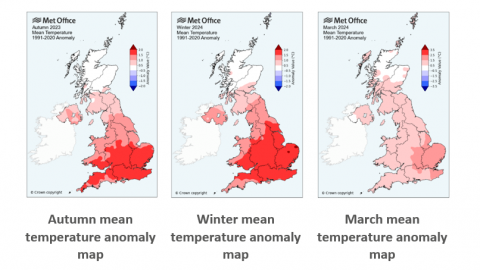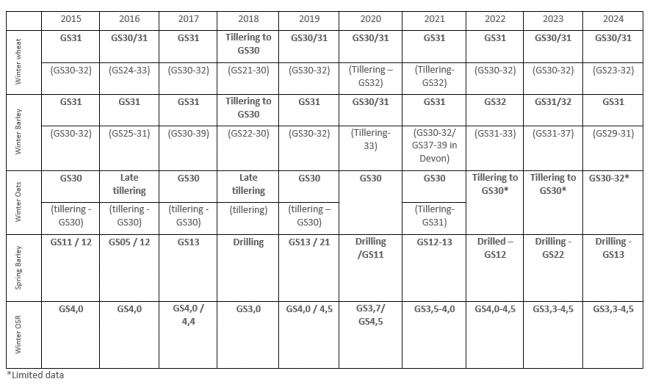Pete Berry, Roger Sylvester-Bradley & Kate Storer
Crop Development
Crop development during autumn, winter and spring is primarily driven by temperature which affects the rate of leaf and tiller emergence – the warmer it is, the faster leaves and tillers appear. But then the trigger for reproductive development and the start of stem extension depends on a combination of photoperiod (longer days in spring) and vernalisation (exposure to cool temperatures of 0 – 12°C). The most effective vernalisation temperatures are around 8oC.
According to Met Office figures, despite being very wet, it was a mild autumn and winter. September, October, December, February and March were all milder than average, with only November and January being closer to ‘normal’ (Figure 1). February was the warmest on record in both England and Wales, being particularly warm in the southern half of the UK. The south of England experienced it’s wettest February since records began in 1836, and East Anglia broke both the warmest and wettest records in February 2024 (Met Office). Overall, it has been a mild season so far (Figure 1) but very wet and dull. As a result, a higher than usual proportion of winter crops didn’t get drilled, or didn’t survive the winter, and many spring crops are still yet to be drilled. While the rain is causing a lot of problems, if crops did manage to get drilled, the conditions have resulted in crop development continuing much as normal for this time of year. It is possible that waterlogging has retarded the development of some crops, especially their tiller production, but reproductive development does not seem significantly different from normal.
Looking back through Crop Action records for mid-April since 2015, winter wheat crops are currently close to average at around GS30-31 (see table below), as are the winter barley crops, typically at GS31. Both wheat and barley are similar to the AHDB benchmark of GS31 by 2nd week of April, probably owing to the milder winter temperatures. Similar to last year, there is a slightly wider range in OSR crop development this year, ranging from GS3,3 to 4,5 with many fields now starting to flower. This may reflect wider range in establishment dates. Spring barley is behind on average though, as most crops are yet to be drilled, with reports of up to ~1/3 of crops drilled in several areas, and many areas yet to start, reflecting the wet March conditions.
Figure 1. Mean daily temperature anomaly maps (Met Office).

Table 1. Crop Growth stages between the 11th and 16th April. Most common growth stage (GS) in bold, followed by range in brackets.


